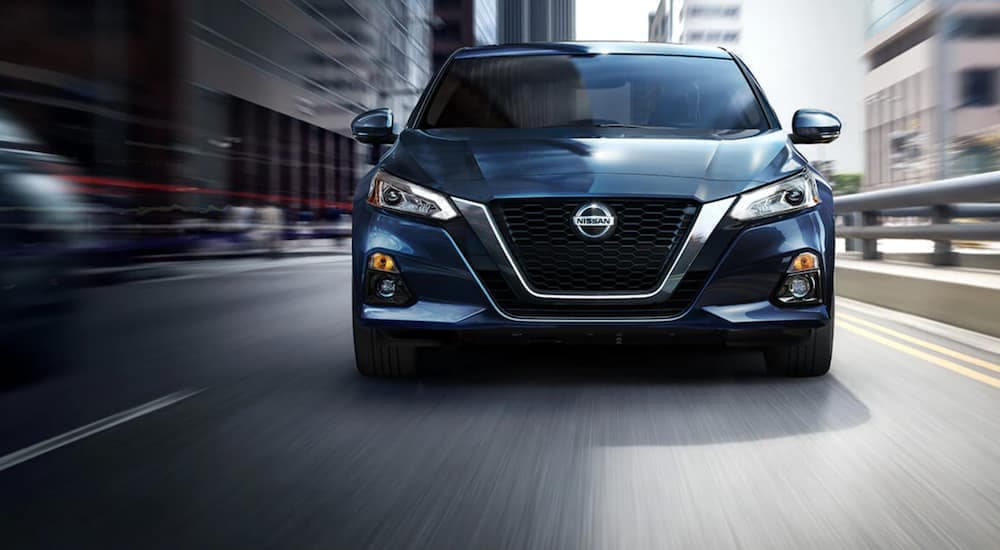If you’re on the hunt for a sporty midsize sedan, you might think the only options to choose from are dull and, well, duller. We have some great news for you: there is a battle between the 2021 Nissan Altima vs 2021 Toyota Camry to infuse some much-needed excitement into a category that sometimes depends too deeply on delivering practicality. It turns out that your sedan can be fuel-efficient and fast, good news for buyers craving performance.
The 2021 Nissan Altima was completely redesigned not long ago and is offered with both front-wheel drive and all-wheel drive powertrains, along with a selection of five different trims. A high-performance VC-Turbo engine tops off the lineup, adding a boost of horsepower for a little extra fun powering out of corners or accelerating onto the highway. A plethora of tech and infotainment features keep the cabin lively, and the long list of luxury features ensures everyone’s comfort during long road trips.
For 2021, the 37-year-old Toyota Camry received a minor exterior refresh. Toyota offers standard driver-assist technology across the trim range, and all-wheel drive is available as an option. While the Camry’s standard 2.5-liter 4-cylinder engine is fairly comparable to that of the Altima, an available V6 represents an older approach to performance and comes at a significant price increase.
Is the 2021 Altima right for you, or would the Toyota Camry be a better fit? We review both in detail here, so you’re equipped with all the information you need to make the right decision.
Comparing Base Models: Value
When it comes to configurations, both the Altima and Camry have plenty of them. These robust lineups try to build in enough variety for mass buyer appeal, but what if you’re price shopping? Both base model vehicles – the Altima S and the Camry LE – start in the mid-$20,000 range, but the Altima is a couple of hundred dollars cheaper. As you travel up the trim range, the price difference becomes more apparent. Which entry-level sedan offers the most bang for the buck?
The Altima S includes 16-inch wheels, a 7-inch infotainment touchscreen and 5-inch driver information display, and a handful of standard Nissan driver-assist systems. Air conditioning, a push-button start with remote start feature, a six-speaker audio system with speed-sensitive volume control, and a 60/40 split rear seat are also standard. There are even more standard features that make the Altima S not your average base model.
The Camry LE sits on standard 17-inch wheels and also offers a 7-inch infotainment touchscreen, however, the driver information display is a little smaller, at 4.2 inches. Unfortunately, the base model Camry doesn’t come standard with a push-button start, nor does it offer a remote start feature. Instead, it features a traditional key. The Camry’s sound system also includes six speakers, but it’s a more basic system that doesn’t adjust the volume with speed changes. The Camry LE does come standard with a selection of driver-assist technologies but, unlike the Altima S, does not offer Rear Automatic Braking.
Which one is the value winner? Our vote is for the 2021 Nissan Altima S.

Comfort Features at the High End: Luxury
Travel to the top of the trim range on the 2021 Nissan Altima and the 2021 Toyota Camry, and you’ll begin to see a widening price gap. The premium Altima SL starts at just under $30,000, while the Camry XSE crosses the $30,000 threshold, as do the Camry TRD and the Camry XSE V6, at $32,260 and $35,620, respectively. Even the Altima VC-Turbo doesn’t climb that high: it lands at just north of $30,000.
With such a big price jump, it’s worth digging into the specs to see why. The Altima SL includes such high-end features as dual-zone automatic temperature control with rear passenger vents, and remote engine start with Intelligent Climate Control, which lets you set the temperature when you start your car, so the cabin is warmed up (or cooled down) when you get in. Leather-wrapped seating with driver’s side memory is standard, along with power front heated seats, a heated, leather-wrapped steering wheel, and special wood-tone trim.
The upper-end Camry XSE includes many of the same standard features but not the heated steering wheel. That’s extra and requires purchasing an option package. Oddly, the Camry XSE doesn’t include visors with illuminated vanity mirrors, a feature that’s standard on every Altima. If you want them, you have to – you guessed it! – add an option package. Also, the Camry XSE’s cabin is accented with metal trim, which is not as warm as the Altima SL’s wood-look trim.
Overall, the Altima SL delivers more features at a lower MSRP. You won’t have to creep over the $30,000 mark to put one in your driveway. The Camry XSE matches the high-end Altima in many respects, but in the midsize sedan segment, even buyers at the upper end of the price range still appreciate a good value. It’s worth noting that Nissan also has an even better Platinum Altima trim, but because it comes standard with all-wheel drive, there really isn’t a comparable Camry trim.
Which one is the luxury winner? Once again, Nissan comes out ahead with the Altima SL.
High-Performance Trims
On the performance end of the price spectrum sit the Altima SR VC-Turbo and the Camry TRD. The VC-T is priced at just over $30,000. If you want the Camry TRD, be prepared to shell out over $32,000. The VC-T features a class-exclusive variable compression turbo DOHC 16-valve 4-cylinder engine designed to constantly adjust for maximum output and fuel economy. It pumps out 248 horsepower and 273 lb-ft of torque.
The Camry TRD challenges that with a V6 engine that delivers more horsepower but less torque. Also, prepare to spend a little more on gas because the Toyota V6 isn’t as fuel-efficient as Nissan’s cutting-edge engine. The Camry TRD comes in at 22 MPG city and 31 MPG highway, while the VC-T delivers 25 MPG city and 34 MPG highway. It may seem like a small difference, but over the course of many years of ownership, the fuel savings will add up.
Nissan’s VC-Turbo engine is the only one of its kind in the category, making the Altima VC-T a unique choice and one that’s difficult to compare. However, because this trim is priced lower than the Camry’s V6-equipped option, buyers should know that not only are they getting a better price – they’re also tapping into cutting-edge technology. Varying compression means the engine is constantly seeking an ideal level of output for performance but also defaulting to the most fuel-efficient method for powering the vehicle. In other words, the engine adapts automatically to accomplish excellent acceleration and best-case fuel efficiency simultaneously. The result is a more refined and optimized ride.
Which one is the performance winner? What can we say: Nissan wins again with the VC-Turbo.

The Altima Brings Excitement to the Segment
If your plans include putting a midsize sedan in the driveway, we recommend test driving a 2021 Nissan Altima. Whether you’re seeking a great value and low price or you want lots of bells and whistles, the Altima lineup has an option for you. Even performance is possible within the segment, thanks to the innovative Altima VC-Turbo. It’s an easy decision, especially when you consider Nissan’s focus on building quality vehicles.



